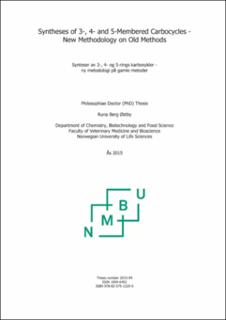Syntheses of 3-, 4- and 5-membered carbocycles : new methodology on old methods
Doctoral thesis
Permanent lenke
https://hdl.handle.net/11250/2687783Utgivelsesdato
2020-11-13Metadata
Vis full innførselSamlinger
- Doctoral theses (KBM) [121]
Sammendrag
The main focus of this thesis was to use new methodology on already well-established methods of preparation of 3-membered, 4-membered and 5-membered carbocyclic compounds with the emphasis on improving them.
Traditional batch dibromocyclopropanations by reaction of bromoform and alkenes under phase-transfer conditions usually require strong base (50% NaOH (aq)), vigorous stirring, and often long reaction times. When flow chemistry in a microreactor was used, the reactions were found to be smooth, rapid, and high-yielding under ambient conditions when 40% (w/w) NaOH was used as the base. A key requirement for the success of this method was the use of the slug flow technique and an aqueous-to-organic flow ratio (AO ratio) of 4. A representative selection of alkenes, displaying a variety of structural features, was used as substrates. When unsaturated alcohols were used as substrates, the yields obtained were dependent on the structure of the alcohol. Hovedfokus i denne avhandlingen har vært å bruke ny metodologi på allerede veletablerte metoder for fremstilling av karbosykliske 3- og 4- og 5-ringsforbindelser med håp å forbedre dem.
Tradisjonelle metoder for dibromsyklopropaneringer i vanlige reaksjonskolber ved reaksjon med bromoform og alkener under faseoverføringsbetingelse krever vanligvis sterk base (50% NaOH (aq)), svært kraftig røring og ofte lange reaksjonstider. Ved å benytte "flow"-kjemi i en mikroreaktor, ble reaksjonene funnet å være enkle å utføre i tillegg til at de var raske og gav høyt utbytte under normale betingelser, men hvor det var nødvendig med en basestyrke på kun 40% (w/w) NaOH. Et nøkkelkrav for denne metodens suksess, var bruk av "slug flow"-teknikken og et vannfase-organiskfase-forhold (AO forhold) på 4. Et representativt utvalg av alkener med forskjellige strukturelementer ble brukt som substrater. Med umettede alkoholer som substrat, viste det seg at utbyttene var svært avhengige av strukturen til alkoholen.
